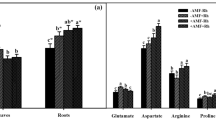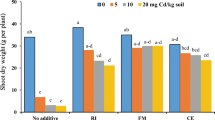Summary
Foliar sprays of growth regulators affected the per cent distribution of individual species of the dominant group of Aspergilli in the rhizosphere ofCajanus cajan Millsp. Generally, physiological groups occurred in the order of starch hydrolyzing > nitrifiers > denitrifiers. A shift in the balance in favour of denitrifiers and a parallel increase in the incidence ofAzotobacter in the rhizosphere of NAA- and IAA-treated plants was observed. Sprays of 2,4-D, NAA and IAA promoted starch-hydrolyzing group. On the other hand, with sprays of MH and gibberellin, their incidence was considerably reduced. It is suggested that transport and accumulation of carbohydrates in the roots might limit the incidence of this group of bacteria in MH- and gibberellintrated plants. 2,4-D and NAA sprays stimulated amino-acid requiring bacteria while MH treatment tended to preferentially stimulate group-V organisms. These results are discussed with reference to metabolic changes in the plant.
Similar content being viewed by others
References
Agnihothri, V. P., Studies on Aspergilli XIV. Effect of foliar spray of urea on the Aspergilli of the rhizosphere ofTriticum vulgare L. Plant and Soil20, 364–370 (1964).
Alvim Paulo De, T., Net assimilation rate and growth behaviour of beans as affected by gibberellic acid, urea and sugar sprays. Plant Physiol.35, 285–288 (1960).
Cleland, R. E., The relation between auxin and metabolism.In: Handbuch der Pflanzen Physiologie XIV. Growth and Growth Substances, 754–783 (1961).
Currier, H. B., Day, B. E. and Crafts, A. S., Effects of maleic hydrazide on plants. Bot. Gaz.112, 272–280 (1951).
Ebben, M. H., Brown root rot of tomatoes III. The bacterial flora of the rhizosphere. Ann. Appl. Biol.48, 817–823 (1960).
Fred, E. B. and Waksman, S. A., A Laboratory Manual of General Microbiology. McGraw-Hill Book Co., Inc. N.Y. (1928).
Humphries, E. C., Mineral components and ash analysis. Determination of nitrogen.In: Moderne Methoden der Pflanzenanalyse I, 479–481, Springer-Verlag (1956).
Katznelson, H., Observations on the rhizosphere effect.In: The Ecology of Soil Fungi, Liverpool University Press (1960).
Lakshmi-Kumari, M., Rhizosphere Microfloras and Host-Parasite Relationships. Ph.D. Thesis. Madras University (1961).
McIlrath, W. J., Response of the cotton plant to maleic hydrazide. Am. J. Botany37, 816–819 (1950).
Nelson, N., A photometric adaptation of the Somogyi method for the determination of glucose. J. Biol. Chem.153, 375–380 (1944).
Paul, E. A. and Tu, C. M., Alternation of microbial activities, mineral nitrogen and free amino acid constituents of soils by physical treatment. Plant and Soil22, 207–219 (1965).
Ramachandra-Reddy, T. K., Foliar spray of urea and rhizosphere microflora of rice (Oryza sativa L.). Phytopath. Z.36, 286–289 (1959).
Rouatt, J. W. and Katznelson, H., The comparative growth of bacterial isolates from rhizosphere and non-rhizosphere soils. Can. J. Microbiol.3, 271–275 (1957).
Rouatt, J. W. and Katznelson, H., Initiation of the rhizosphere effect. Bact. Proc.38, 9 (1958).
Rovira, A. D., Plant root excretions in relation to the rhizosphere effect. I. The nature of root exudate from oats and peas. Plant and Soil7, 178–194 (1956).
Rovira, A. D., Interactions between plant roots and soil microorganisms. Ann. Rev. Microbiol.19, 241–266 (1965).
Samborski, D. J., Forsyth, F. R. and Person, C., Metabolic changes in detached wheat leaves floated in benzimidazole and the effect of these changes on rust infection. Can. J. Botany36, 591–601 (1958).
Sethunathan, N., Foliar sprays of growth regulators and rhizosphere effect inCajanus cajan Millsp. I. Quantitative changes. Plant and Soil33, 62–70 (1970).
Smith, W. H. and Peterson, J. L., The influence of the carbohydrate fraction of the root exudate of red clover,Triticum pratense L., onFusarium spp. isolated from the clover root and rhizosphere. Plant and Soil25, 413–424 (1966).
Somogyi, M., Notes on sugar determination. J. Biol. Chem.195, 19–23 (1952).
Stuart, N. W. and Cathey, H. M., Growth and metabolism ofChrysanthemum as modified by nutrients and gibberellin. Plant Physiol.34, suppl. xvi (1959).
Westlake, D. W. S. (1955), Quoted by Fletcher, W. W.,In: Herbicide and the Soil, pp. 20–62, Blackwell and Oxford (1960).
Wort, D. J., Effects of herbicides on plant composition and metabolism.In: The Physiology and Biochemistry of Herbicides, pp. 291–334, Academic Press, N.Y. (1964).
Author information
Authors and Affiliations
Additional information
Part of Doctoral thesis, University of Madras, 1966; Memori No.66 from the Centre for Advanced Study in Botany.
Rights and permissions
About this article
Cite this article
Sethunathan, N. Foliar sprays of growth regulators and rhizosphere effect inCajanus cajan Millsp.. Plant Soil 33, 71–80 (1970). https://doi.org/10.1007/BF01378197
Received:
Issue Date:
DOI: https://doi.org/10.1007/BF01378197




